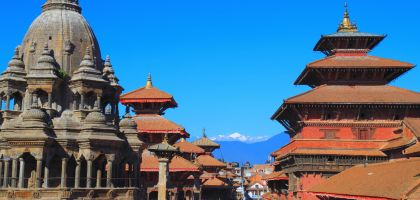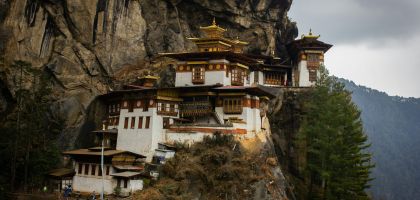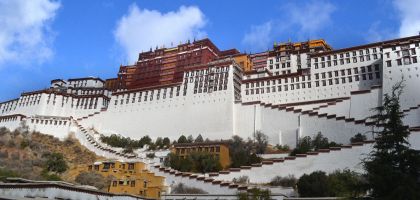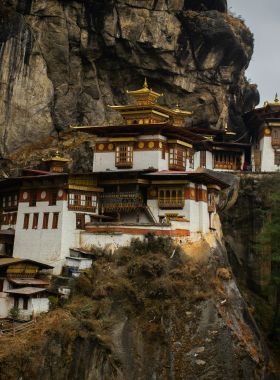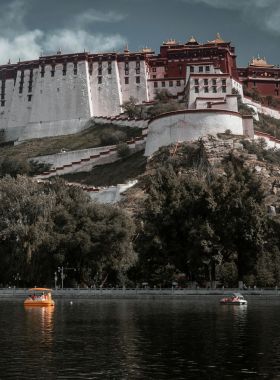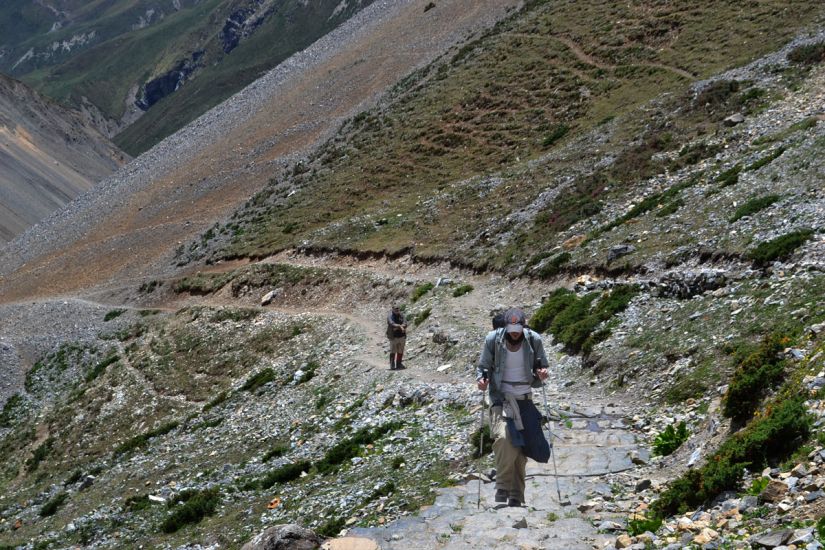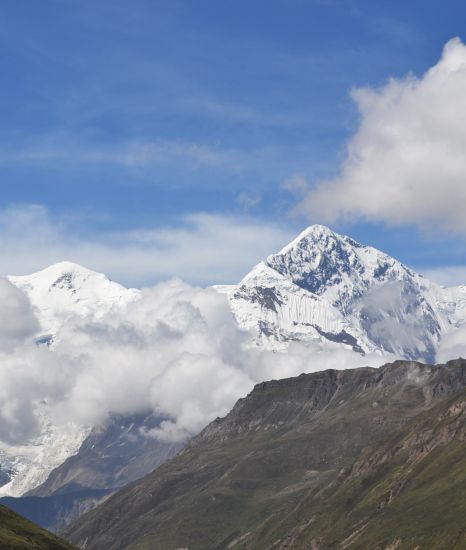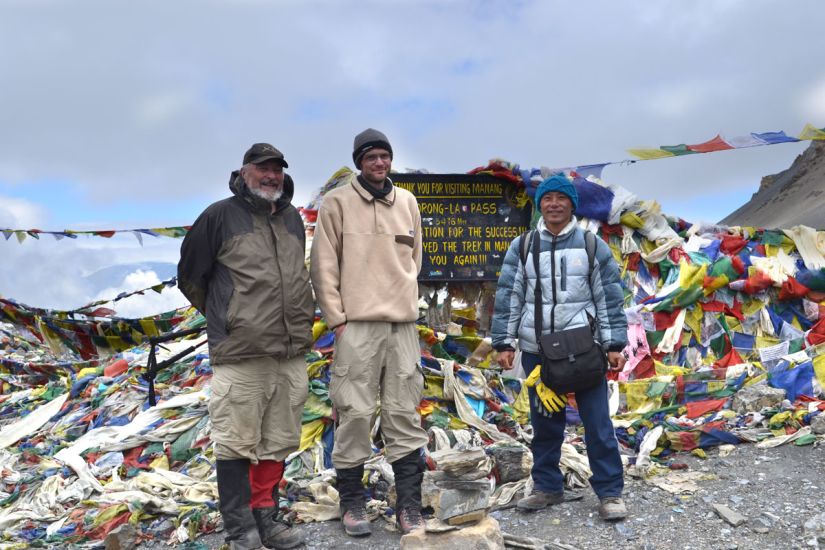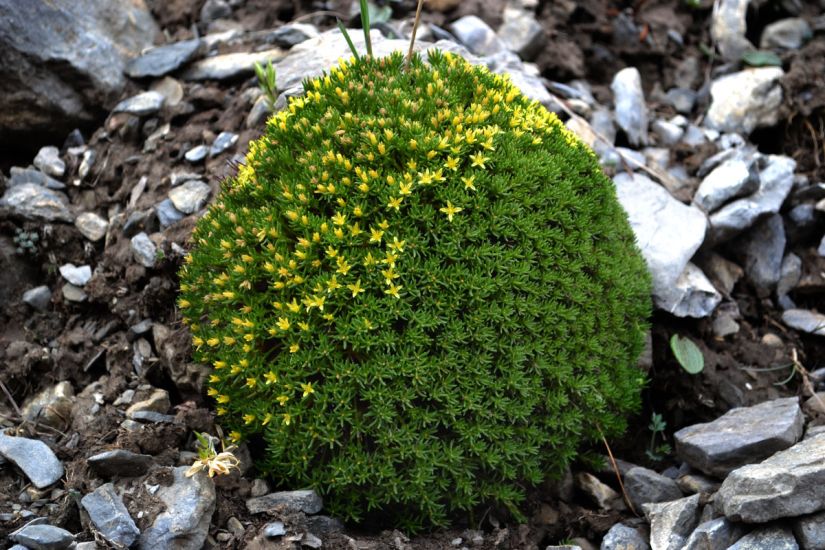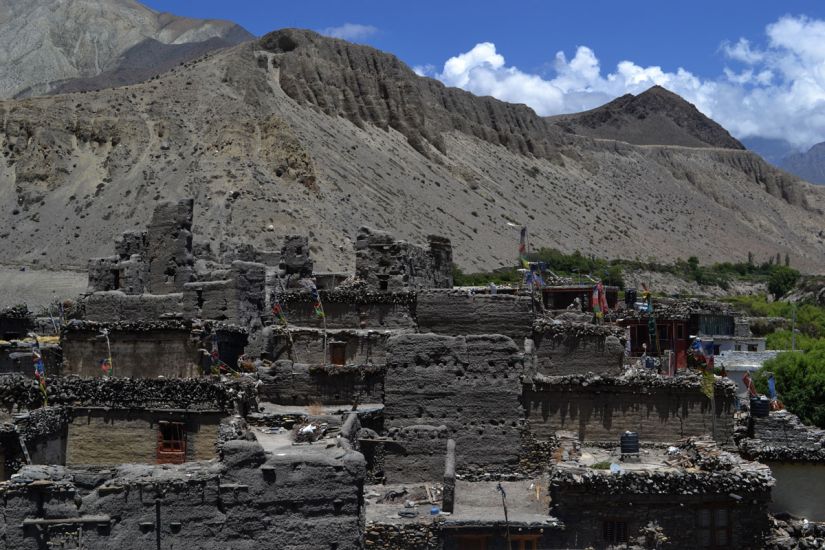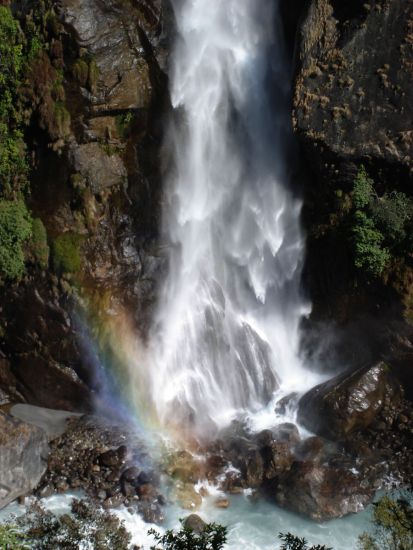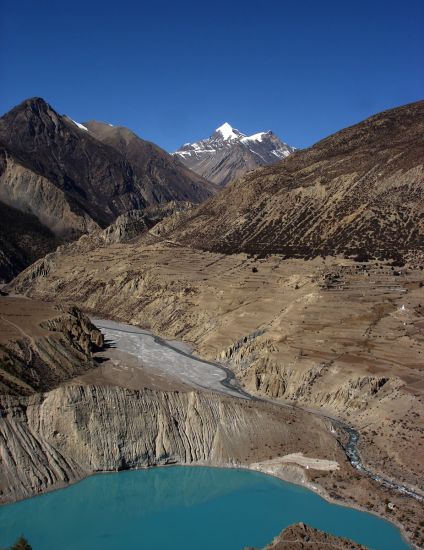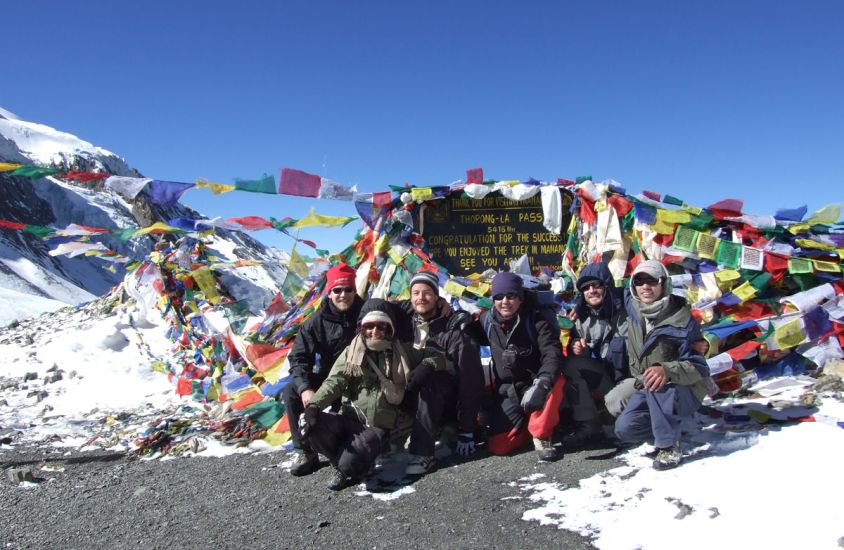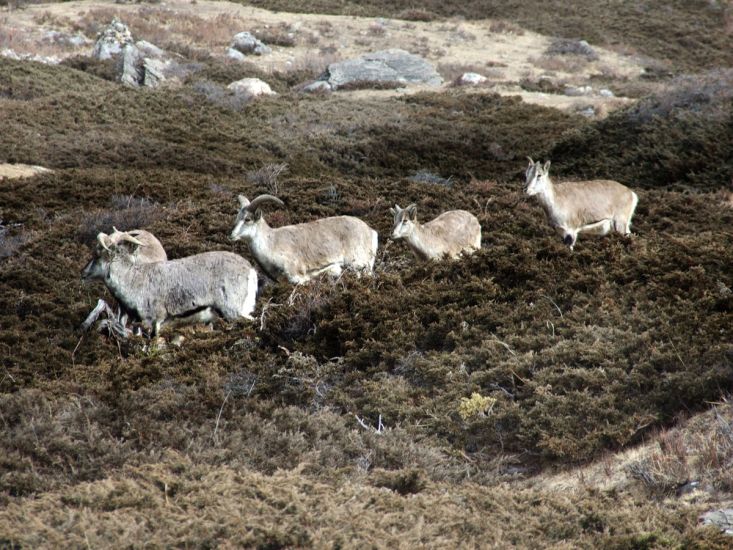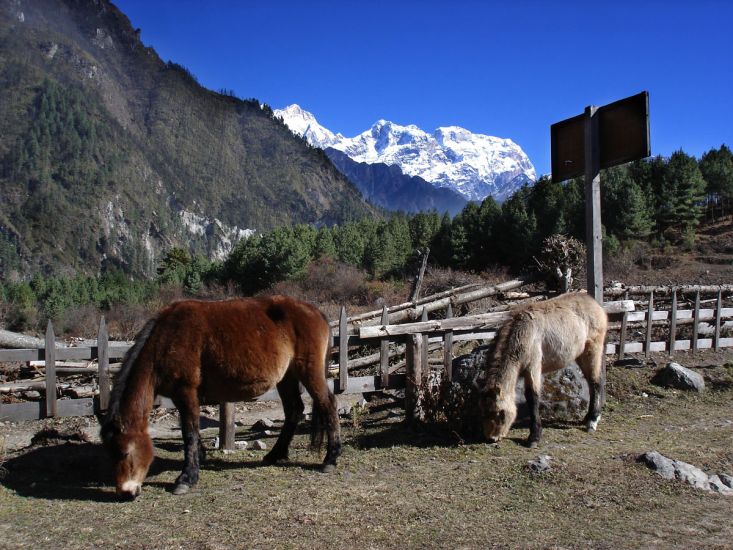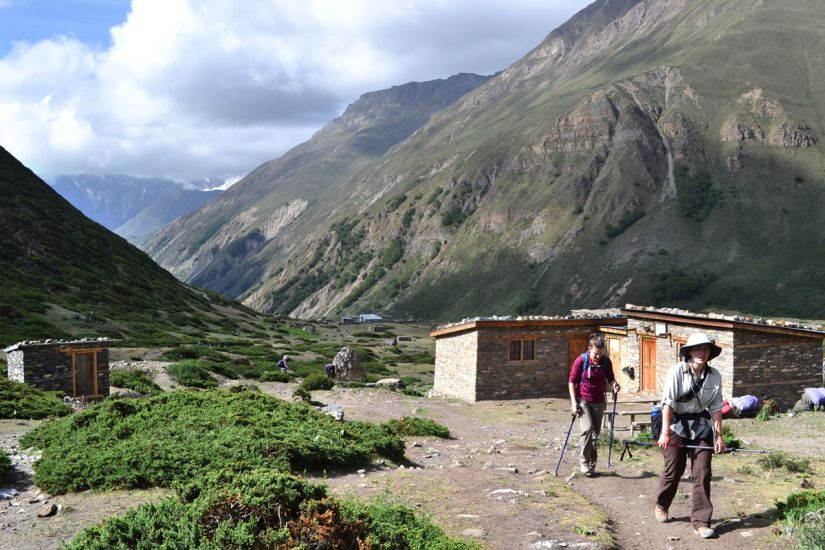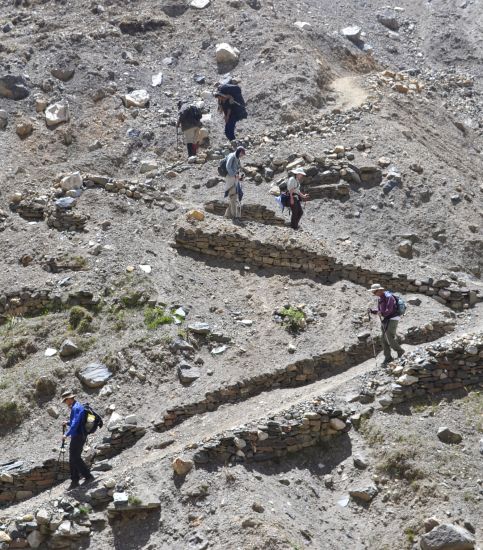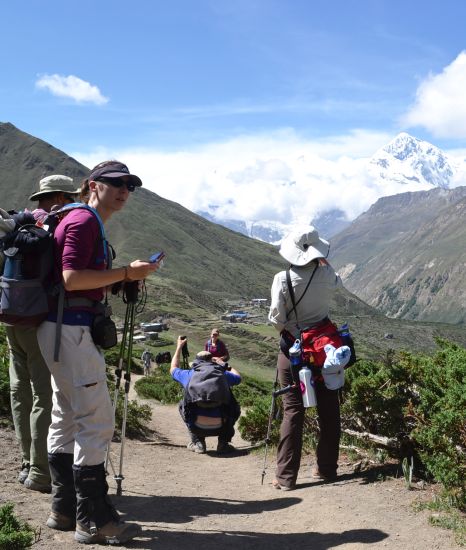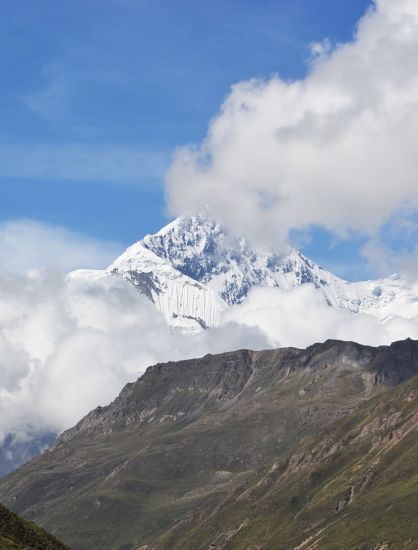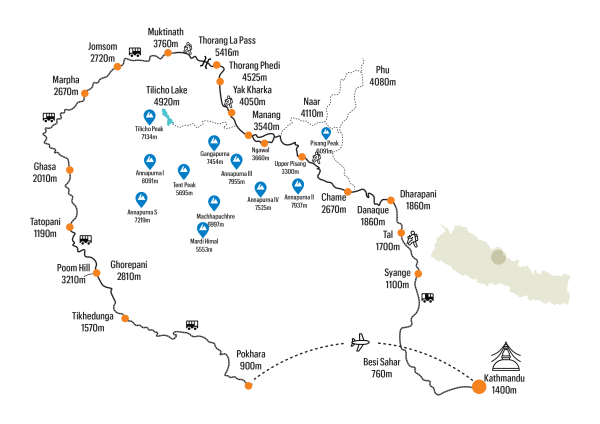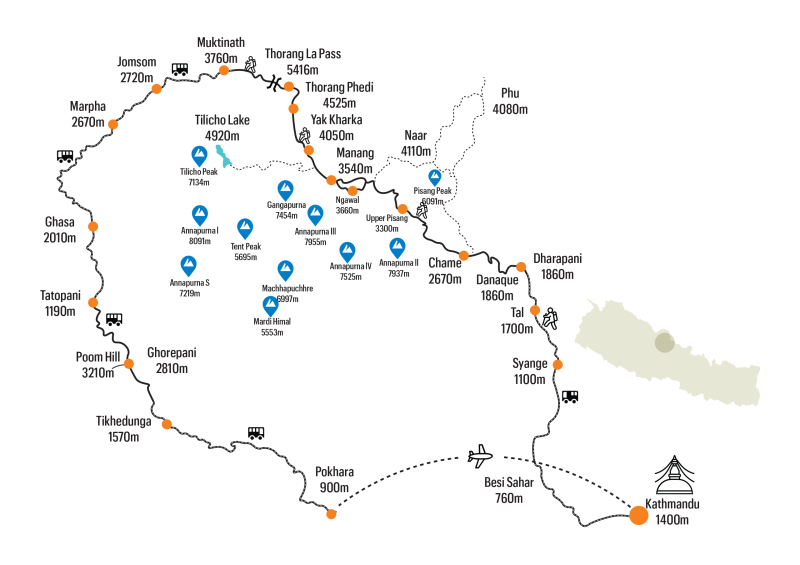Annapurna Circuit Trek
14 Days / Nepal
Activity
Difficulty Level
Destinations
Trip Start / End
Max Altitude
Accommodation
Travel Style
Best time to travel
Personalized Travel Advice

Dev Raj Nepal
+977 9851096523
Detailed Itinerary
01
DAY
01
Your journey begins as you land at Tribhuvan International Airport in Kathmandu, Nepal’s vibrant capital. After clearing immigration and customs, you will be warmly greeted and transferred you to your hotel. Take some time to rest after your flight or explore the bustling streets of Thamel, known for its lively atmosphere, shops, and restaurants.
If time permits, you may visit nearby cultural landmarks such as Kathmandu Durbar Square or Swayambhunath Stupa (Monkey Temple). In the evening, enjoy a welcome dinner at a traditional Nepalese restaurant, followed by a briefing about the Annapurna Circuit trek by your guide.
Arrival in Kathmandu
Your journey begins as you land at Tribhuvan International Airport in Kathmandu, Nepal’s vibrant capital. After clearing immigration and customs, you will be warmly greeted and transferred you to your hotel. Take some time to rest after your flight or explore the bustling streets of Thamel, known for its lively atmosphere, shops, and restaurants.
If time permits, you may visit nearby cultural landmarks such as Kathmandu Durbar Square or Swayambhunath Stupa (Monkey Temple). In the evening, enjoy a welcome dinner at a traditional Nepalese restaurant, followed by a briefing about the Annapurna Circuit trek by your guide.
02
DAY
02
Early in the morning, take a long but scenic drive towards Besisahar, the gateway to the Annapurna Circuit trek. The journey takes you through winding mountain roads, terraced fields, and traditional villages along the Trishuli and Marsyangdi Rivers.
After reaching Besisahar, switch to a four-wheel-drive jeep for a rugged off-road journey to Dharapani, passing picturesque settlements like Syange and Tal, where the Marsyangdi River forms breathtaking waterfalls.
Arriving in Dharapani, you’ll feel the change in altitude as the air becomes fresher and cooler. The drive will take us about 8-9 hours.
Kathmandu – Besisahar – Dharapani
Early in the morning, take a long but scenic drive towards Besisahar, the gateway to the Annapurna Circuit trek. The journey takes you through winding mountain roads, terraced fields, and traditional villages along the Trishuli and Marsyangdi Rivers.
After reaching Besisahar, switch to a four-wheel-drive jeep for a rugged off-road journey to Dharapani, passing picturesque settlements like Syange and Tal, where the Marsyangdi River forms breathtaking waterfalls.
Arriving in Dharapani, you’ll feel the change in altitude as the air becomes fresher and cooler. The drive will take us about 8-9 hours.
03
DAY
03
Our Annapurna Circuit trek begins today. Your first day is a gradual ascent through pine and fir forests, crossing several suspension bridges over the roaring Marsyangdi River. The trail passes through Bagarchhap, a charming village with Tibetan-style houses, before reaching Timang, where you get the first glimpses of Manaslu (8,163 m). The route continues along rocky trails and forested landscapes until you arrive at Chame, the district headquarters of Manang. Here, you can enjoy natural hot springs to relax your muscles. Overnight at a Tea House in Chame.
Dharapani – Chame
Our Annapurna Circuit trek begins today. Your first day is a gradual ascent through pine and fir forests, crossing several suspension bridges over the roaring Marsyangdi River. The trail passes through Bagarchhap, a charming village with Tibetan-style houses, before reaching Timang, where you get the first glimpses of Manaslu (8,163 m). The route continues along rocky trails and forested landscapes until you arrive at Chame, the district headquarters of Manang. Here, you can enjoy natural hot springs to relax your muscles. Overnight at a Tea House in Chame.
04
DAY
04
Leaving Chame, the trail leads through dense forests and steep cliffs, offering magnificent views of Annapurna II and Pisang Peak. As you cross a long suspension bridge over the Marsyangdi River, the valley opens up, revealing stunning Himalayan vistas. A steep climb leads to Upper Pisang, a small village perched above Lower Pisang, known for its ancient Buddhist monastery and panoramic views of the Annapurna range. The higher altitude here aids in acclimatization. Overnight at a guesthouse in Upper Pisang.
Chame – Upper Pisang
Leaving Chame, the trail leads through dense forests and steep cliffs, offering magnificent views of Annapurna II and Pisang Peak. As you cross a long suspension bridge over the Marsyangdi River, the valley opens up, revealing stunning Himalayan vistas. A steep climb leads to Upper Pisang, a small village perched above Lower Pisang, known for its ancient Buddhist monastery and panoramic views of the Annapurna range. The higher altitude here aids in acclimatization. Overnight at a guesthouse in Upper Pisang.
05
DAY
05
Taking the upper route through Ghyaru and Ngawal, this part of the trek rewards you with breathtaking views of Annapurna II, III, and IV, Gangapurna, and Tilicho Peak. The trail is steeper but offers a quieter, more scenic alternative to the lower route. As you pass through Ghyaru, an ancient Tibetan-style village, you’ll witness local lifestyles, prayer wheels, and chortens. Continuing towards Ngawal, the air gets thinner, and the landscape becomes more barren yet mesmerizing. Overnight at a guesthouse in Ngawal.
Upper Pisang – Ngawal
Taking the upper route through Ghyaru and Ngawal, this part of the trek rewards you with breathtaking views of Annapurna II, III, and IV, Gangapurna, and Tilicho Peak. The trail is steeper but offers a quieter, more scenic alternative to the lower route. As you pass through Ghyaru, an ancient Tibetan-style village, you’ll witness local lifestyles, prayer wheels, and chortens. Continuing towards Ngawal, the air gets thinner, and the landscape becomes more barren yet mesmerizing. Overnight at a guesthouse in Ngawal.
06
DAY
06
Descending from Ngawal, the trail merges with the main Annapurna Circuit route, passing through Bhraka/Braga (3,360 m), a village known for its 600-year-old monastery clinging to the cliffs. Take time to explore the monastery and admire the stunning views of Annapurna III and Gangapurna.
From here, it’s a short trek to Manang, the largest village in the region. This village is situated at an altitude of 3, 540m, and has bakeries, shops, and even a Himalayan Rescue Association center, where trekkers can learn about altitude sickness. Overnight at a Tea in Manang.
Ngawal – Bhraka – Manang
Descending from Ngawal, the trail merges with the main Annapurna Circuit route, passing through Bhraka/Braga (3,360 m), a village known for its 600-year-old monastery clinging to the cliffs. Take time to explore the monastery and admire the stunning views of Annapurna III and Gangapurna.
From here, it’s a short trek to Manang, the largest village in the region. This village is situated at an altitude of 3, 540m, and has bakeries, shops, and even a Himalayan Rescue Association center, where trekkers can learn about altitude sickness. Overnight at a Tea in Manang.
07
DAY
07
A crucial day for acclimatization, you can explore Gangapurna Lake, a glacial lake with stunning turquoise waters, or hike up to Praken Gompa, where a Buddhist lama offers blessings to trekkers. Another option is a short hike to Ice Lake (4,600 m) for an additional challenge. The village itself has plenty to explore, including small cafes serving fresh pastries and yak cheese. This rest day helps your body adjust to the increasing altitude. Overnight at a guesthouse in Manang.
Acclimatization Day in Manang
A crucial day for acclimatization, you can explore Gangapurna Lake, a glacial lake with stunning turquoise waters, or hike up to Praken Gompa, where a Buddhist lama offers blessings to trekkers. Another option is a short hike to Ice Lake (4,600 m) for an additional challenge. The village itself has plenty to explore, including small cafes serving fresh pastries and yak cheese. This rest day helps your body adjust to the increasing altitude. Overnight at a guesthouse in Manang.
08
DAY
08
Leaving Manang, the landscape transforms into alpine meadows with grazing yaks. The trail steadily climbs through Tenki Village, offering views of Tilicho Peak and the Marsyangdi Valley. A gradual ascent leads to Yak Kharka, a remote settlement with stunning mountain surroundings. Due to the higher altitude, it’s important to hike slowly and stay hydrated. Overnight at a basic guesthouse in Yak Kharka.
Manang – Yak Kharka
Leaving Manang, the landscape transforms into alpine meadows with grazing yaks. The trail steadily climbs through Tenki Village, offering views of Tilicho Peak and the Marsyangdi Valley. A gradual ascent leads to Yak Kharka, a remote settlement with stunning mountain surroundings. Due to the higher altitude, it’s important to hike slowly and stay hydrated. Overnight at a basic guesthouse in Yak Kharka.
09
DAY
09
From Yak Kharka, the trail becomes more rugged as you ascend towards Thorong Phedi, the base camp for crossing Thorong La Pass. Pass through Ledar and cross a landslide-prone area before reaching Phedi. Some trekkers opt to hike another hour to High Camp (4,800 m) for an easier ascent the next day. Overnight at a basic Teahouse in Thorong Phedi.
Yak Kharka -Thorong Phedi
From Yak Kharka, the trail becomes more rugged as you ascend towards Thorong Phedi, the base camp for crossing Thorong La Pass. Pass through Ledar and cross a landslide-prone area before reaching Phedi. Some trekkers opt to hike another hour to High Camp (4,800 m) for an easier ascent the next day. Overnight at a basic Teahouse in Thorong Phedi.
10
DAY
10
This day of the Annapurna Circuit trek entails climbing up to the famed Thorong La Pass, situated at an altitude of 5,416m. Start before dawn to reach Thorong La Pass, where prayer flags flutter against the backdrop of snow-covered peaks. Enjoy panoramic views before descending towards Muktinath, a sacred Hindu and Buddhist pilgrimage site. Visit Muktinath Temple, known for its eternal flame and 108 water spouts. Overnight at a guesthouse in Muktinath.
Cross Thorong La Pass – Muktinath
This day of the Annapurna Circuit trek entails climbing up to the famed Thorong La Pass, situated at an altitude of 5,416m. Start before dawn to reach Thorong La Pass, where prayer flags flutter against the backdrop of snow-covered peaks. Enjoy panoramic views before descending towards Muktinath, a sacred Hindu and Buddhist pilgrimage site. Visit Muktinath Temple, known for its eternal flame and 108 water spouts. Overnight at a guesthouse in Muktinath.
11
DAY
11
The Annapurna Circuit trek end here. After breakfast, drive to Marpha, a picturesque village famous for its apple orchards and traditional Thakali culture. Stroll through its narrow stone-paved alleys, visit Tashi Lhakhang Monastery, and try locally made apple brandy. Overnight at a guesthouse in Marpha.
Muktinath – Marpha
The Annapurna Circuit trek end here. After breakfast, drive to Marpha, a picturesque village famous for its apple orchards and traditional Thakali culture. Stroll through its narrow stone-paved alleys, visit Tashi Lhakhang Monastery, and try locally made apple brandy. Overnight at a guesthouse in Marpha.
12
DAY
12
Today, we will have to drive for about 6-7 hours to reach Pokhara. A scenic drive through the Kali Gandaki Gorge, passing Jomsom, Tatopani (hot springs), and lush valleys before reaching Pokhara. Overnight at a hotel in Pokhara.
Marpha – Pokhara
Today, we will have to drive for about 6-7 hours to reach Pokhara. A scenic drive through the Kali Gandaki Gorge, passing Jomsom, Tatopani (hot springs), and lush valleys before reaching Pokhara. Overnight at a hotel in Pokhara.
13
DAY
13
Visit Phewa Lake, Davis Falls, Gupteshwor Cave, and the World Peace Pagoda. Optionally, enjoy paragliding or a boat ride. Overnight at a hotel in Pokhara.
Explore Pokhara
Visit Phewa Lake, Davis Falls, Gupteshwor Cave, and the World Peace Pagoda. Optionally, enjoy paragliding or a boat ride. Overnight at a hotel in Pokhara.
14
DAY
14
A short flight back to Kathmandu, where you can explore or relax before your departure.
Kathmandu – Departure
A short flight back to Kathmandu, where you can explore or relax before your departure.
Includes / Excludes
Inclusions
-
All accommodations on a twin sharing basis.
-
Meals mentioned in the itinerary.
-
All trekking permits.
-
English speaking licensed guide.
-
Porters.
-
All transfers.
Exclusions
-
Drinks, tip and expenses of personal nature.
-
Meals not mentioned in the itinerary.
-
Extra expenses due to nature and unforeseen events.
-
Travel Insurance.
-
Nepal visa.
Trip Info
The Annapurna Region is a spectacular part of Nepal, home to some of the highest mountains in the world, including Annapurna I (8,091 m) and Machhapuchhre (Fishtail). The region is defined by deep valleys such as the Kali Gandaki and Manang valleys, high passes like Thorong La, and glacier-fed rivers that shape the stunning landscape. Trekkers pass through terraced fields, alpine forests, and high-altitude deserts, making every day of the Annapurna Circuit trek visually unique.
The area is rich in culture, with Gurung and Thakali communities living in villages like Ghandruk, Chhomrong, Ngawal, and Marpha. Visitors can experience traditional architecture, local cuisine, monasteries, and museums that showcase the heritage of the region. Festivals and rituals add to the cultural charm, giving trekkers a chance to engage with local life.
The Annapurna Region also offers diverse natural beauty. Rhododendron forests bloom in spring, while cascading waterfalls and cliffs follow the trail along the Modi Khola and Kali Gandaki rivers. Wildlife is abundant, including mountain birds, Himalayan marmots, and sometimes even snow leopards in the higher areas.
Travelers should plan for seasonal variations. Spring (March–May) and autumn (September–November) provide clear skies and pleasant temperatures, while winter brings snow at high altitudes, and monsoon season (June–August) can make trails slippery. Proper preparation ensures that every trekker enjoys the mix of natural beauty, adventure, and cultural discovery that the Annapurna Region offers.
Annapurna Circuit Trek
The Annapurna Circuit Trek is one of Nepal’s most famous trekking routes, offering an incredible journey through diverse landscapes, rural farms, traditional villages, and dramatic mountain scenery.
The trek typically takes around 14 days, starting from the lush lowlands near Besisahar and moving into high-altitude regions, passing through terraced fields, river valleys, and rhododendron forests.
Along the way, trekkers experience the changing environment from subtropical greenery to arid highlands as they approach the Thorong La Pass, the highest point of the trek at 5,416 meters.
As you move through the trail, the views are constantly changing and breathtaking. Trekkers can enjoy panoramas of peaks like Annapurna I, Annapurna II, Annapurna III, Machhapuchhre (Fishtail), Hiunchuli, and Gangapurna.
You will pass through charming villages such as Ghandruk, Chhomrong, Ngawal, and Marpha, where you can experience local Gurung and Thakali culture, architecture, and cuisine.
The Annapurna Circuit trek also offers natural wonders including glacier-fed rivers, cascading waterfalls, cliffs, alpine lakes, and lush forests that transform into snow-covered landscapes at higher altitudes.
The Annapurna Circuit is both an adventurous and culturally enriching experience. Trekkers can explore monasteries and visit the Gurung Museum in Ghandruk, witness traditional festivals, and interact with local people who have maintained their heritage for generations.
The high mountain passes and narrow trails provide both challenges and rewards, making it a once-in-a-lifetime journey. Rest days in places like Manang help with acclimatization while offering more time to enjoy the spectacular scenery and local culture.
Overall, the Annapurna Circuit Trek is a complete Himalayan experience, combining natural beauty, adventure, and cultural discovery.
The best time to do the Annapurna Circuit Trek is during the two main trekking seasons in Nepal:
Autumn (September to November): This is considered the peak trekking season in Nepal. The weather is generally clear and stable, with mild temperatures and excellent visibility of the mountain peaks. The trekking trails are dry, and the skies are often a brilliant blue, making it ideal for stunning views and trekking conditions.
Spring (March to May): This is another great time to trek in the Annapurna region. The weather is warm, and the flowers, particularly rhododendrons, are in full bloom, adding a splash of color to the trek. The clear skies and moderate temperatures make for comfortable trekking conditions, although it can be a bit warmer compared to autumn.
Both seasons offer the best chances for clear weather, comfortable temperatures, and stunning landscapes. Avoiding the monsoon season (June to August) and winter (December to February) is recommended due to heavy rains, muddy trails, and potential snow at higher altitudes during these months.
Throughout the trip, private vehicles will be used for transfers and sightseeing. These include comfortable cars or SUVs, which are good for navigating both urban and rural areas. These vehicles are chosen for their comfort and reliability, ensuring a smooth and enjoyable journey between destinations. They are equipped to handle various road conditions and provide a high level of convenience for travelers.
Food on the Annapurna Circuit Trek offers a delightful mix of traditional Nepali and Tibetan cuisine, providing trekkers with local flavors and ingredients. Dal Bhat, a hearty and nutritious meal consisting of rice, lentil soup, and vegetables, is a staple in Nepali trekking cuisine and is often served multiple times a day. It’s usually accompanied by a side of pickle for extra flavor. Momo, steamed or fried dumplings filled with meat or vegetables, are a popular snack or lunch option along the trail. For breakfast, Tibetan bread, a type of flatbread served with butter or jam, is commonly enjoyed, providing energy for the day ahead. Warm soups, such as vegetable soup, noodle soup, or thukpa (a Tibetan noodle soup), are common, offering comfort and warmth, especially in the colder regions.
In Kathmandu and Pokhara, the accommodations are more modern and comfortable, with a range of hotels available that cater to different budgets. You can expect private rooms with en-suite bathrooms, hot showers, and other amenities like Wi-Fi and room service, providing a relaxing stay before and after your trek.
In the higher-altitude regions of the Annapurna Circuit Trek, accommodations consist of Guesthouses, which are simple, family-run lodges that provide a place to sleep, meals, and a warm environment. Guesthouses are basic but functional, with rooms typically featuring twin beds, wooden floors, and a blanket for warmth.
Some Guesthouses may offer additional amenities such as hot water (for a fee) or charging facilities, though this varies from place to place. Though the accommodations in the Guesthouses can be simple, they are a fundamental part of the trekking experience, allowing trekkers to connect with the local culture and landscape while enjoying the warmth and hospitality of the local people.
Clothing & Footwear
- Waterproof and breathable jacket and pants
- Insulating layers (fleece, down jacket)
- Thermal base layers
- Hiking pants and shorts
- Warm hat and sun hat
- Gloves
- Warm socks
- Sturdy, waterproof hiking boots
- Comfortable sandals or shoes
Gear & Accessories
- Backpack (50-70 liters)
- Sleeping bag (rated for cold temperatures)
- Trekking poles
- Headlamp with extra batteries
- Sunglasses
- Sunscreen and lip balm
- Water bottles or hydration system
- Water purification tablets or filter
- Toiletries
- Quick-dry towel
Remember to pack light and efficiently.
For the Annapurna Circuit Trek in Nepal, both a visa and a trekking permit are required due to the area’s restricted status and conservation policies.
Nepal Visa
Tourist visa for Nepal must be obtained by all foreign nationals (except Indian citizens and a few other exceptions), either at the airport upon arrival or from a Nepalese embassy beforehand. Visa fees vary depending on the duration of stay: $30 for 15 days, $50 for 30 days, and $125 for 90 days. You can choose the first option.
For more information: Read Nepal Immigration Website
Required Permits for the Annapurna Circuit Trek
ACAP (Annapurna Conservation Area Permit): The Annapurna Circuit Trek passes through the Annapurna Conservation Area, Nepal’s largest protected region. Trekkers are required to obtain an ACAP permit, which helps support conservation efforts, local communities, and sustainable tourism in the region.
Note: This permit will all be arranged by us.
Altitude Sickness: The Annapurna Circuit Trek reaches altitudes of over 5,400 meters (Thorong La Pass), making altitude sickness a potential risk. Symptoms include headache, nausea, dizziness, and shortness of breath. Proper acclimatization, gradual ascents, and staying hydrated are essential to minimize this risk.
Weather Conditions: The weather in the high Himalayas can be unpredictable. Sudden changes in temperature, snowstorms, or rainfall can occur, especially during the monsoon season. Trekking in the colder months (winter) may bring snow accumulation and slippery conditions at higher altitudes, making it more challenging.
Trekking Injuries: The rugged terrain, especially in remote areas, increases the risk of slips, falls, and sprains. Sturdy footwear and careful trekking are vital, particularly when navigating steep or rocky sections of the trail.
Isolation & Limited Access to Medical Care: Some sections of the Annapurna Circuit are far from medical facilities. In the event of injury or illness, evacuation can be difficult, especially in remote or high-altitude areas. Having adequate insurance that covers evacuation is highly recommended.
Spectacular Scenery: The trek offers some of the most breathtaking views in the world, with panoramas of the Annapurna, Dhaulagiri, Manaslu, and Machapuchare ranges, as well as pristine landscapes of valleys, rivers, and glaciers.
Cultural Immersion: Trekking through remote villages like Manang, Pisang, and Marpha provides an enriching experience to immerse in the culture, traditions, and lifestyles of the mountain communities. You’ll encounter Buddhist monasteries, temples, and Tibetan-style architecture.
Sense of Achievement: Reaching the Thorong La Pass is a significant milestone and provides a sense of accomplishment. Standing at the top of one of the highest trekking passes in the world is an incredibly rewarding experience.
Spiritual Experience: The sacred Muktinath Temple, nestled in the Himalayas, is a powerful place for spiritual reflection, attracting both Hindus and Buddhists alike.
Connection with Nature: Trekking in the Annapurna region brings trekkers closer to nature, with the opportunity to witness diverse ecosystems, from subtropical forests to alpine meadows. The peace and tranquility of the remote Himalayan landscapes provide a perfect retreat from daily life.
Physical Challenge: The trek is a great physical challenge, boosting endurance and strength while offering the reward of a healthy, active adventure in the mountains. The journey will leave you with lasting memories and a deeper appreciation for the natural world.
Diverse Landscapes and Scenic Views
During the Annapurna Circuit Trek, expect to experience a dramatic change in landscapes as you ascend from the lowland forests to high-altitude terrain. Trek in Nepal offers diverse ecosystems, from subtropical forests full of rhododendrons to barren, rocky landscapes at higher altitudes. The trek provides stunning vistas of the Annapurna and Dhaulagiri mountain ranges, as well as clear views of Machapuchare and Manaslu. You’ll pass through rivers, valleys, and glaciers, offering plenty of opportunities for awe-inspiring photographs.
Cultural Encounters in Mountain Villages
As you journey through traditional villages like Manang, Pisang, and Marpha, expect to immerse yourself in the local culture and hospitality. The communities along the trail are steeped in Buddhist traditions, with monasteries, prayer flags, and Tibetan-style architecture. You’ll have the chance to interact with local people, experience their way of life, and learn about their customs, making this trek not only an adventure but also a cultural exploration.
High-Altitude Challenges
The Annapurna Circuit Trek is a challenging high-altitude trek that will test your physical endurance. Expect to experience the effects of higher altitudes as you make your way to Thorong La Pass (5,416 m), one of the highest trekking passes in the world. The air gets thinner as you approach the top, and proper acclimatization is crucial to avoid altitude sickness. With rest days in places like Manang, you’ll have time to adjust to the altitude and appreciate the panoramic views of the surrounding peaks.
Acclimatization and Rest Days
Throughout the trek, you’ll have designated acclimatization days, particularly in Manang. These rest days are essential to prevent altitude sickness and allow your body to adjust to the thinning air. During these breaks, you can explore the village, soak in the stunning views, or take short hikes to nearby viewpoints. These days will also give you the opportunity to relax and enjoy the natural beauty that surrounds you.
Sacred Sites and Spiritual Encounters
Expect spiritual moments along the trek, especially when you visit Muktinath, a revered Hindu and Buddhist pilgrimage site. The temple complex, set in a stunning location, offers a peaceful retreat with its eternal flame and 108 water spouts. Trek in Nepal allows you to experience the profound spiritual connection that many travelers feel in the presence of such sacred sites, providing a sense of tranquility and reflection.
Physical and Mental Challenge
The Annapurna Circuit Trek is a physically demanding journey, and you should expect long days of trekking, often with steep ascents and descents. However, the physical challenge is balanced by the rewards of reaching the Thorong La Pass and experiencing the unique landscapes of the Himalayas. The trek will test your limits, but it will also leave you with an immense sense of achievement and the satisfaction of having conquered one of the most famous treks in the world.
FAQs
Personalized Travel Advice

Dev Raj Nepal
+977 9851096523
